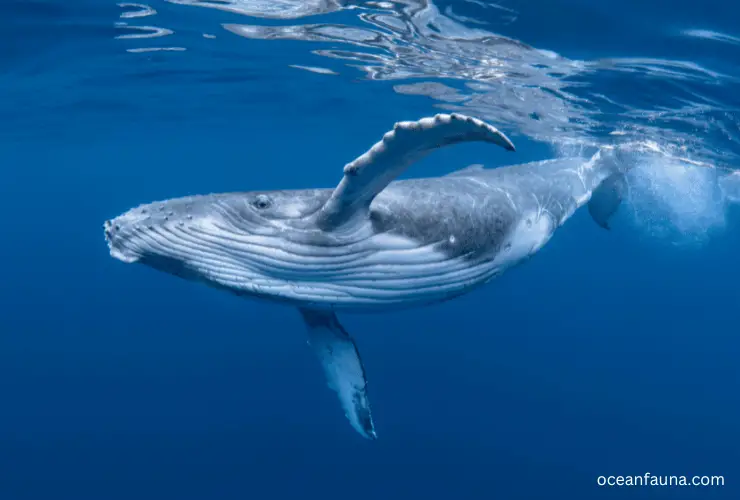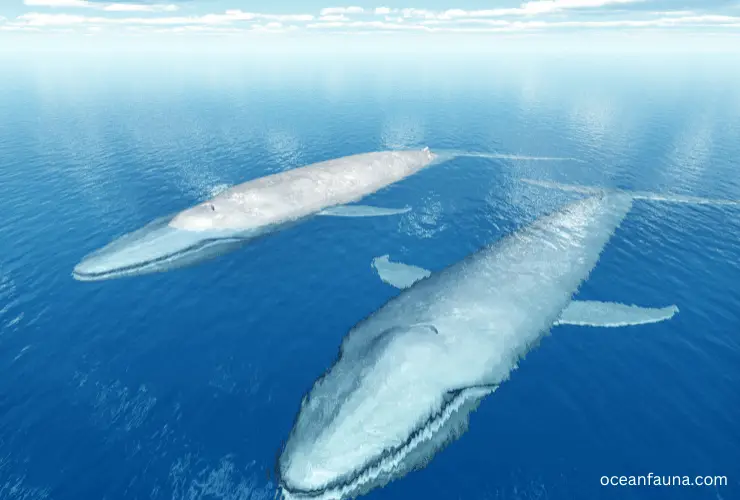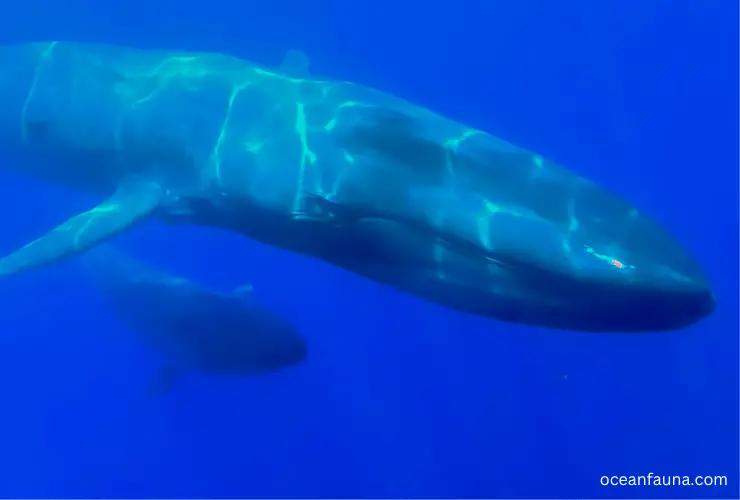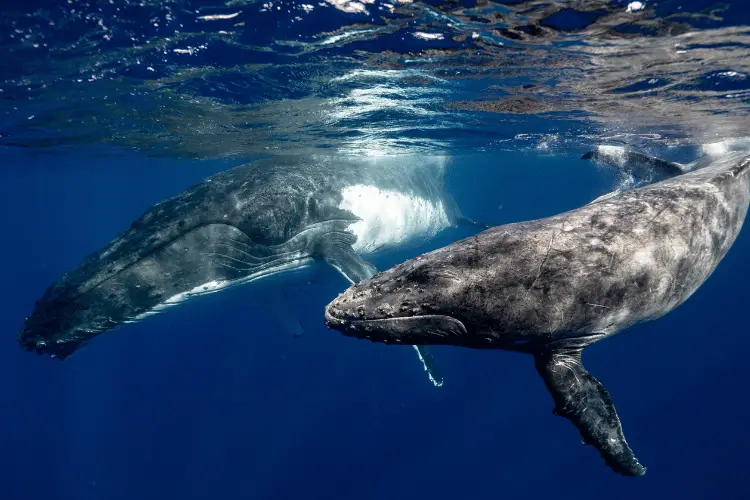The Gulf of Mexico (GOM) is a semi-enclosed sea that is connected to the Atlantic Ocean. If you’re a whale enthusiast, you may wonder, “Are there any whales in the Gulf of Mexico?” The answer is yes. Five common whale species are there in the Gulf of Mexico. They are: Rice’s, Bryde’s, Sperm, Humpback, and North Atlantic Right Whale.
Want to know more about them? Don’t worry. This blog will tell you all about these whales and their activities in the Gulf of Mexico. I also explained the best time to visit them, including precautions. So read on.
Which Whales Are There in the Gulf of Mexico?

The Gulf of Mexico is home to a diverse range of whale species. Each of these whales has unique characteristics, such as size, color, behavior, and habitat. Here are brief details of each.
Rice’s Whale (Balaena Ricei)
Rice’s whale, also known as the Gulf of Mexico whale, is a baleen species typically found in this region. It’s critically endangered due to its very small population.
This whale has narrow, elongated baleen plates. These plates help filter zooplankton from water. Rice’s whales in the Gulf feed mainly on krill and copepods. They live in shallow waters, usually less than 40 meters deep.
Bryde’s Whale (Balaenoptera edeni)
Bryde’s, another baleen whale, is common in the Gulf of Mexico. It’s active year-round and protected under Marine Mammal Protection Act. This species is small, up to 50 feet long, with a slender body and an elongated head.
It has three parallel ridges on its head. Bryde’s whales eat small fish and squid, diving briefly and shallowly to hunt.
Sperm Whale (Physeter macrocephalus)
Sperm whales, the largest toothed whales, favour the warm Gulf waters. They are abundant especially in winter and spring. Sperm whales have large, square heads that make up one-third of their body.
They also have powerful tails. Known for unique clicking sounds, they use these to locate squid, their main food. They dive deep, up to 2,000 meters, for prey.
Humpback Whale (Megaptera novaeangliae)
Humpback whales, another baleen species, are in the Gulf from late spring to early fall. They are famous for their long, white fins and powerful songs. These songs can travel hundreds of kilometers underwater.
Humpbacks feed on small fish, like herring and mackerel. They dive up to 20 meters and are protected in the Gulf.
North Atlantic Right Whale (Eubalaena glacialis)
The North Atlantic right whale is critically endangered. It’s protected due to its high risk status. Known for its V-shaped blowhole and head callosities, this baleen whale feeds on small marine life like copepods.
In winter, North Atlantic right whales migrate here to give birth in warm, shallow waters. They face threats from ship strikes and fishing gear entanglements.
Are There Blue Whales in the Gulf of Mexico?

Blue whales migrate long distances for food and breeding. It is nearly impossible to find blue whales in the Gulf of Mexico. The Gulf of Mexico is smaller and shallower than many ocean regions. Blue whales prefer deeper and larger waters for feeding and breeding.
Why Do Blue Whales Avoid the Gulf? The Gulf of Mexico lacks large krill populations, essential for blue whale diets. Blue whales rarely venture into areas without enough krill. They are often in regions like the Antarctic, known for abundant krill.
The Gulf’s waters are warmer than where blue whales usually live. They prefer colder waters, which are better for krill growth. Warmer waters may not have enough krill for blue whales.
In contrast, the Gulf of Mexico hosts other whale species. Rice’s, Bryde’s, sperm, humpback, and North Atlantic right whales are common. These species have different diets and thrive in less deep waters than blue whales.
When Can You See Whales in the Gulf of Mexico [Best Time to Go]
The ideal time to see whales in the Gulf of Mexico is between December and April. During this time, whales migrate from Alaska to the warmer waters near Mexico and Texas for birthing.
In this period, the Gulf is bustling as thousands of humpbacks arrive. They come here to mate, give birth, and nurse their young. Gulf waters are vital for these whales. They offer the ideal temperature and environment for the survival of their young.
Besides humpbacks, you might see massive blue whales and elusive sperm whales. Their presence in the Gulf is rare and exciting for enthusiasts. Witnessing these majestic animals up close as they breach and fluke is a memorable experience.
Best Spots for Whale Watching
Planning a whale-watching trip in the Gulf? There are several spots for great sightings. The warm waters off the coasts of Texas and Mexico are ideal. You can also see whales from the shore at places like Grand Isle, Louisiana, Galveston Island, Texas, and Tampico, Mexico.
Tips While Visiting Whales in the Gulf of Mexico

Whales are majestic creatures of the Gulf of Mexico. Planning a trip to see Gulf of Mexico whales? Remember these tips for a safe and enjoyable experience.
Choosing a Whale-Watching Tour Operator
When visiting Gulf whales, it’s crucial to choose a reputable whale-watching tour operator. Choose a tour provider committed to ethical whale-watching and marine conservation. Make sure the tour operator is National Oceanic and Atmospheric Administration (NOAA) permitted, operating legally with the right safety gear.
Respecting Marine Life
Respect marine life while whale watching. Avoid disturbing the whales. Keep a safe distance of at least 100 yards and don’t block their path. Adhere to National Marine Fisheries Service (NMFS) guidelines on approaching and observing marine mammals. This helps protect the whales and other marine life.
Dressing and Preparing for the Trip
The Gulf’s weather is unpredictable. Dress appropriately for sudden changes. Wear warm, waterproof clothing. Even on sunny days, conditions can shift quickly on the water. Don’t forget gear like sunglasses, sunscreen, and hats for sun protection. Bring a camera or binoculars to capture the experience.
Conclusion
So, what’s to say? Are there whales in the Gulf of Mexico or not? Hopefully, you got your answer. While blue whales are rarely seen in this part of the world, other species such as humpback, Bryde’s, Rice’s, sperm, and North Atlantic right whales can be spotted from December to April.
If you are planning a trip to witness these magnificent creatures in their natural habitat, choose a reputable tour operator and respect marine life while being prepared with the necessary gear and clothing.

